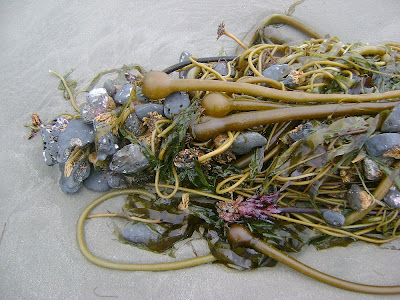Saturday was a having-it-all day: high tide with storm surf for a few hours, then some charismatic fishes leaping up the Salmon Cascades, then a terrific bird talk with an identification for the September 5 mystery-birds.
It was supposed to be a space between storms, cloudy no rain. And the high tide only a 7.1. 'Oh,' thought I, 'I will go to the beach, take a walk, and then sit and read.' But the moment I came around the curve where you first can see the ocean, I understood there was a flaw in the plan: surf breaking way out, and lots of foam (and also rain).
Pelicans, too. Any day with pelicans in it is already a good day. But I got tired of pitching the camera up at the wet sky or out over the waves and pushing the button without much hope of success. Blurry waves and microscopic pelicans. So no pelican new pix.
Rialto Beach, September 25, 2010 (Click for larger image.)
(I checked the NOAA warnings when I got home and there was nothing, but today they tell us it's still surfy out there:
...A HIGH SURF ADVISORY HAS BEEN ISSUED FOR THE NORTH AND CENTRAL WASHINGTON COAST...WHICH IS IN EFFECT UNTIL 3 PM PDT THIS AFTERNOON. SEAS HAVE REACHED 15 FEET AT THE CAPE ELIZABETH BUOY THIS MORNING. THIS IS THE HIGHEST THE SURF HAS BEEN SO FAR THIS SEASON."
So I spent a couple of hours watching, sitting on first one log, then another higher up the beach, then another. A lot of other people were doing the same, not always being careful. Some people came along the beach who had gotten caught in a wave up to their waists.
On the way home, I detoured up the Sol Duc River to see if the salmon were jumping. I assumed not, as there didn't seem to be much water in the river at the highway crossings, but I thought I'd go see with my own eyes, and anyway the forest is very beautiful there. There actually was a cheerful plenitude of water in the river at Salmon Cascades, and by golly the coho salmon were jumping. Not too many. Jump. Wait. Jump.
Sol Duc River at River Mile 59 , September 25, 2010 (Click for larger image.) The Forest at the Cascade (Click for larger image.)
The Forest at the Cascade (Click for larger image.)
Decided not to try to capture a fish in flight with the camera. Too hard; pretty soon you stop seeing them as charismatic embodiments of life at its most determined, and instead see only one missed photo op after another. So I just watched. This one from last year will do, no?
A Coho Salmon on October 18, 2009 (Click for larger image.)
In the evening, Barbara Blackie's talk at the Feiro about Olympic Coast birds. She talked about our own familiar critters, common murres and auklets and puffins and murrelets and sooty shearwaters. I was looking out the window at Jupiter rising incredibly bright over the Strait, when I heard her say something about 'tens of thousands of sooties'. Immediately I thought of the flocks of mystery seabirds that had been on and over the water north of James Island at the beginning of the month. I asked after the talk, and sure enough she thinks my skillion floating and flying seabirds were sooty shearwaters, she heard there was a shearwater event on the outer coast earlier this month.
I just KNEW somebody would know, disgraced myself by asking the impossible question ('please tell me what did I see even though I couldn't see clearly enough to describe it to you') over and over until someone knew the answer.
The NOAA folks at the talk said that although there was an algal bloom in progress offshore, there was so far not a mortality event. I reported I had seen a whole lot of latte-colored foam stirred up by yesterday's swell. If there is a wreck, it probably won't be scoters, they are finished molting and can just leave (which last year they could not).






















































